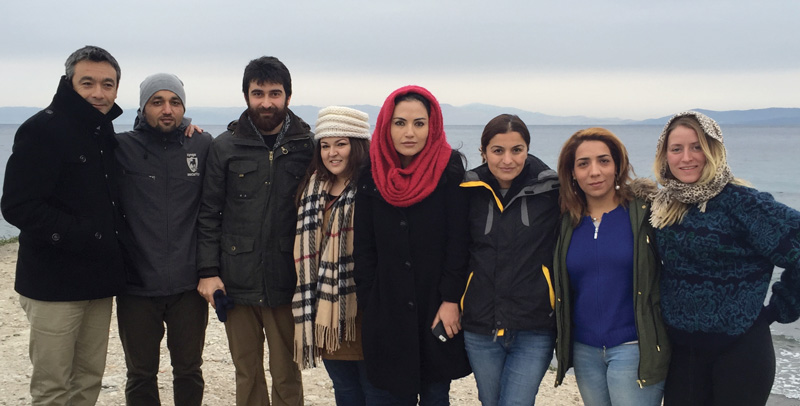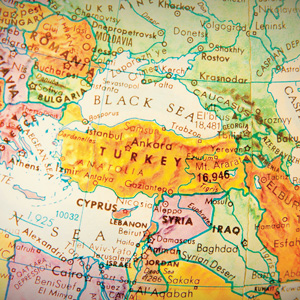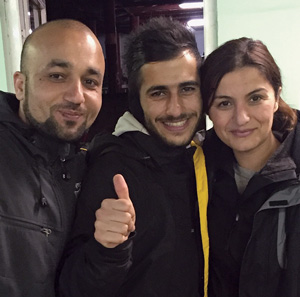Volunteer helping refugees in Greece knows their plight well — she was once one of them

Alumna Humah Bargzie Talai, third from right, and fellow volunteers traveled from across the globe to assist refugees on the Greek island of Lesbos.
If you had seen what Humah Bargzie Talai(M.S., ’13) packed for a 10-day trip abroad late last year, you might have wondered where in the world she was going and what she planned to do there.
On her flight out of San Francisco International Airport, Talai’s luggage bulged with things plucked seemingly at random from the shelves of her local Walmart: jumbo bags of lollipops, tubes of Orajel, multi-packs of cotton underwear, three-for-$1 packs of earrings and dozens of backpacks, scarves and pairs of socks.
Yet when Talai, 39, returned home to Orinda, where she lives with her husband, Behrouz, a tax manager, and the couple’s daughter, Hila, 9, she had little more than the clothes on her back.
She had given away practically everything — cash, clothes, trinkets, even her own winter jacket and spare T-shirts and jeans — to desperate refugees and migrants on Lesbos, the Greek island that had been on the frontlines of the worst refugee crisis since World War II.
“I felt like, ‘Wow, these people are so desperate.’ So that was the whole idea, to come back with nothing,” says Talai, who earned her graduate degree in counseling.
Gateway to Hope

Lesbos was a gateway for refugees and migrants hoping for a new life in Europe. Each day, thousands of Syrians, Afghans, Iraqis, Pakistanis and others fleeing war and poverty crowded onto rubber dinghies and set off from Turkey for the short but perilous journey across a narrow strait to the small Greek island. Many perished when their boats capsized.
Even knowing the dangers, a staggering number of people have undertaken the crossing. Nearly 857,000 reached Greece by sea in 2015, according to the U.N. High Commissioner for Refugees. The human tide has slowed due to toughened border policies among European Union countries, yet the influx continues: 155,000 arrived through April.
Born in Kandahar, Afghanistan, Talai understands firsthand the forces that drive people from their own homeland.
One day, when she was about 4, her father left for work, never to be seen or heard from again. Abdul-Khaliq Bargzie was presumably a casualty of the decade-long Soviet-Afghan war, but the truth behind his disappearance “for the most part, remains a mystery,” Talai says.
Leaving Home
After her husband disappeared, Talai’s mother, Fatima, spirited her three young daughters into neighboring Pakistan, where the family lived, first in a refugee camp and later with relatives, until relocating to the United States in 1984.
Eventually, the family settled in Concord, California. Talai did undergraduate work in psychology at California State University, East Bay, then returned to the CSU system to study counseling at SF State.
Her decision to volunteer in Greece came as little surprise to those who knew her at SF State. Gloria Gregg, a professor emerita and longtime lecturer in the Department of Counseling, recalled Talai as someone with a “passion for peace and justice” and a willingness to help others “in circumstances of poverty, trauma and chaos.”
As the migrant crisis worsened in 2015, Talai felt increasingly helpless. Then she got a call from a friend, Nahid Fattahi, a graduate student at Santa Clara University who was also from Afghanistan and had fled during the Soviet era. Would Talai go to Lesbos with her to help refugees?
“I knew she was someone who cared about humanitarian causes, so I had a feeling she’d say yes,” Fattahi said.

A refugee who arrived from Turkey gives a thumbs-up to volunteers Humah Bargzie Talai, right, and volunteer Maqbul Sadiqi of Berlin.
Caring Cause
Talai and Fattahi could pay for their own airfare and hotel, but they would need cash to buy supplies and contribute to humanitarian efforts. The pair launched a GoFundMe campaign, and money poured in from SF State classmates, neighbors, friends and fellow Afghan-Americans.
In just 11 days, the campaign raised $11,000, Talai says. With another $6,000 contributed outside GoFundMe, Talai and Fattahi were good to go. They reached Lesbos on Dec. 27.
On a wind-chilled beach called Kratigos, Talai, Fattahi and other volunteers arrived before dawn each day to greet migrants and refugees who reached shore on rickety boats — wet and cold yet grateful to be alive — with warm hugs and emergency supplies.
“Some of them had no expressions on their faces — no joy, no sadness, just a blank,” Talai said. “They told me that it would get to the point where the waves were so high and the boat was rocking so much, they thought, ‘We’re going to die.’ ”
Unlike most volunteers, Talai was able to communicate with Afghans in their native Pashto. Afghanistan was the second most common country of origin, behind Syria, for those arriving in Greece.
“There was one Afghan family, and the little boy kept crying, so I asked his father, ‘Is he OK?’ The father said that his son missed his family members, and I said, ‘What do you mean, they’re all here.’
“He said, ‘No, we started a couple of days ago, but we lost a couple of family members.’ The prior boat capsized and some of them got rescued, but some of them drowned,” Talai says.
“The little boy was 3 and I will never forget his name — Zmaray, that translates [from Pashto] to ‘lion.’ I was telling him, ‘Your name is Zmaray, so you have to be brave.’ And I do think he was. He was very brave.”
History’s Lesson
Europe’s refugee crisis is neither history’s nor the world’s first mass population displacement.
Formation of the nation-state, based on an ideology of ethnically homogeneous populations, would have been impossible without intentional displacement of groups who did not fit state identity criteria. Both World Wars resulted in widespread destruction that prevented people from staying put. And crises of staggering proportions are happening today across Africa and Asia.
What sets apart today’s European crisis? SF State’s Lucia Volk, professor of international relations and Middle East and Islamic studies, takes us behind the headlines.

Lucia Volk
“What makes this refugee crisis different is that it plays into the West’s ‘Muslims against us’ conflict narrative that replaced the Cold War narrative of ‘communists against us,’” says Volk, who is working on a book about Arab refugees in Germany.
While Western states happily granted political asylum to those escaping communist regimes, they react with fear and suspicion to war refugees from the Muslim world, she says. It’s a reaction largely resulting from military interventions in the Middle East, the 9/11 attacks and economic insecurity created by the post-2008 market crash, she adds.
Care for registered internationally displaced people — over 20 million worldwide, including 3 million in the Middle East and 3.5 million in Europe — often in border area camps, falls to the United Nations High Commissioner for Refugees and nongovernmental organizations. Yet it is individual nation-states that remain the final arbiters of individual asylum applications, Volk explains.
What many who follow the news don’t realize, she adds, is that nation-states design legal regimes that keep refugees out. Refugees, Volk says, become people without agency, awaiting, as stated on the UNHCR website, “one of three possible solutions: repatriation, local integration or resettlement.”
By ANNE BURKE